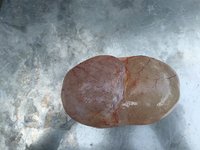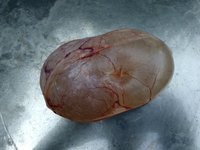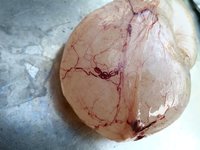I wonder if your chicken is dealing with this:I just recently took one of my chickens to an Aviary Vet as she was limping severely on her left leg. I thought she might have had some sort of infection in her foot, but couldn't see any signs of that. She was eating, but she wasn't her self and the lack of mobility concerned me. When we got her into the vets she was limping but only on her left side. The right side was fine. There was no issue with her feet or legs he said. He noticed she had some fluid in her belly and said we needed to explore this further. I thought she was my chicken that was laying no shell or soft shell eggs for the last 2 months. They did an ultrasound on her and found that she had a grape cluster of ovarian cysts and one of them was the size of a small orange. He said chickens only have a left side ovary so that's why she was only limping on her left leg and that's what gave him a clue that she might be having female issues. He gave me 3 options. One they can give her an implant into her pituitary gland that would tell her ovaries to stop and give her a rest. With this solution the implant could last 3 months or up to a year. No egg laying during that time, probably. It may not reduce or eliminate the cysts but he said she could still move around and she was still eating so she could be okay with getting that rest. He didn't see any signs of cancer and since she had her merck shot as a baby chick he didn't feel that cancer was in the picture. She's also just turned 2 years old. He said if she was a commercial egg layer then he would definitely consider her a good candidate for cancer since most of the commercial chickens do have cancer by the age of 2. With the implant they would need to check her again and see if the implant was helping with fluid and keeping the cysts in check. If not, then we would need to look at this further. It's still possible that she could have further complications with this method. The approximate cost for this is around $300-450. The 2nd option was to open her up and remove the cysts and check her abdomen for any growths or abnormalities. This would be invasive and would require several days at the vets along with a hefty surgery bill. Approximate costs would be around $2500 for just the surgery and hospital stay. There is also a chance of a complication or when opening her up they find something bad and well that could end it for her. The third choice was to do nothing and send her home and see if some miracle happens and it clears up. He didn't see this is a very good option, but it was one that I could consider. I've already spent over $300 on the visit and imaging they did to find the cysts. I'm making my decision today as to what to do. He told me putting her down is not an option at this point as she is still mobile enough to have a decent life and she's still eating. He also shared with me that female issues with chickens, like this are very normal.
Hope this helps others as they try to learn more about their chickens.
https://www.backyardchickens.com/t/...arian-cystadenocarcinomas/0_100#post_12973951








